Do-it-yourself country paths: a review of the best ideas
Spending most of the time at the dacha, everyone wants to have there not only a place to work, but also to relax, admiring the beauty of the house, flowering trees, bright flower beds. And walking around the site is better with beautiful paths, invented and built according to your own design.
Specialized construction stores offer customers a huge variety of materials to bring the territory of summer cottages into a well-groomed, beautiful place. And the owner of the dacha will be able not only to show the dignity of his wallet, but also a violent imagination, which allows, at a minimum cost, to turn the territory of a suburban area into an unusual recreation area.
Content::
- Site selection and preparation for road works on the site
- Features of laying a brick country path
- How to make a path from sawdust, round timber
- Gravel path in the country
- Stone mini-pavements at their summer cottage
- Concreting paths in the country
- What materials are still suitable for country paths
Site selection and preparation for road works on the site
Any construction business must begin with choosing a place for a future structure, this also applies to paths. Usually they lie where the owners of the dacha like to walk, where they have laid trails. The width of the track will depend on the area of the summer cottage. For a small one, a width of 60-80 centimeters will be enough. If the area is about 10-12 acres, then the track should not be narrower than a meter and a half.
It is necessary to approach the device of the summer cottage seriously, thoroughly, carefully choosing the material, preparing the necessary tool.
It is better to start work in late spring or summer, marking the trail lines. Small pegs connected in one line with a rope are suitable for this. Then the topsoil is removed, the depth of which will depend on the volume of material used. Basically, the average dimensions of the pit for the path reach 15-20 centimeters in depth. It is better to fix the edges with boards of the same width.
The next step will be the choice of material for laying the path. For speed, you can buy ready-made structures made of propylene or prefabricated suburban parquet, but this requires a lot of money. But there are reliable materials like concrete, brick. The tracks from them will last a long time, and they look beautiful. Many people prefer ecological material - wood or stone. It will take longer with them, but you can come up with a variety of patterns on the tracks, paint them in different colors.
Features of laying a brick country path
Brick paths look aesthetically and reliably. A fine gravel pillow is prepared for them. After leveling it, fill the pit with sand, which is also equal to a board with perfectly smooth, even edges, the rule. For the side walls, the brick is laid on the edge and driven halfway into the sandy soil. This is where a rubber mallet comes in handy. The curb is fastened with a solution, and after hardening from the outside, removing the boards, reinforce it with reinforcing pins.
The middle of the path can be laid out with bricks set on the end or laid in width. For the fortress, one row is laid along, the other - across the path, driving in the material one level.
You can hold the bricks together with cement-based glue.
At the end of the work, the gaps are filled with sand, which is poured onto the surface of the masonry and is spread with a brush over the entire section of the road. Crushed stone is poured along the edges of the finished path, carefully tamping it. Bricks can be primed or varnished. Such tracks look beautiful and serve for a long time.
How to make a path from sawdust, round timber
The cheapest and easiest way to build a path in the country is from wood shavings. Usually they are done when the entire space of the site is occupied by beds, flower beds. To make it convenient to pass between them, the paths are covered with shavings that remain from the construction of a house, a barn. In this case, the paths should have clear boundaries, which can be done with bricks, boards.
The chips poured into the prepared foundation pit are easily leveled with a garden rake. It will last one or two seasons, and then it can be put into a hole for compost... The convenience of such a path is that the design of the territory can be changed every summer.
But from a wooden round sawn from dried logs, the track will last longer:
- In height, it should be slightly higher than the depth of the pit. To prevent the wood from rotting, the bottom of the round timber is treated with an antiseptic, and after drying, the entire surface is treated with Kuzbasslak or tar. It will protect from exposure to sunlight, which causes the tree to dry out, cracking.
- Wet sand is poured onto a crushed stone pillow and the first row of wooden material is placed in it tightly to each other.
- The holes between the rows are filled with sand or gravel.
Trails made of wooden material adorn the territory of the cottage, but they do not last long.
Gravel path in the country
Wooden round timber can be used as a curb, and the middle of the pit can be covered with gravel. For this:
- Geotextiles cover the space between the borders of hemp, and gravel on it.
- Each layer of rubble is leveled, and so on until the track is the same height as the level of the land plot.
- Keep in mind that gravel shrinks a lot over time. Therefore, it should be poured just above the desired path thickness.
- A pedestrian path made of gravel can be made colored by artistically filling in crushed stone of different tones from red, brown to pale blue and white.
- For the base, you need to pour on a pillow of sand and crushed stone with a cement mortar of the consistency of sour cream. As soon as it begins to set, add one to two centimeters thick cement-based glue. Multicolored gravel is poured onto it in different patterns.
- In conclusion, a light roller is carefully carried over the surface.
The advantage of gravel is its low cost, self-cleaning property from dirt and dust. But over time, such paths are overgrown with grass. Geotextile fabric will help slow this process down. It will not allow weeds to break through to the top for 7-10 years.
Stone mini-pavements at their summer cottage
For stone paths, the material must be selected especially carefully. The stones should be flat, round, or in the form of slabs. The material is laid on a crushed stone pillow filled with a layer of cement glue. The gaps between the stones are covered with gravel. Be sure to roll the stones at the end of the work.
The advantages of a stone path include its decorative effect and durability.
From round stones, you can lay out beautiful patterns on the path. Then oval stones are laid out with sides in a thick mixture of sand and cement, combined in a 3: 1 ratio with the addition of water to the desired density. Each pebble is pressed into the solution with a rubber mallet. The rows of stones must be checked for evenness of the level of laying. In the middle of the pattern, you can add lighter or darker large pebbles.
At the end of the work, the finished masonry is washed with water from a hose. The composition of stones is moistened with water for another week. Then she will gain rigidity and delight for a long time.
Concreting paths in the country
Digging and marking it for a concrete path is the same as for a brick one. The concreting sequence is still slightly different:
- The sand poured into the pit must go through the stage of moistening and compaction. After these procedures, the layer thickness will be no more than seven centimeters.
- Crushed stone, covered from above, is also compacted.
- To make the track strong, a reinforcing mesh is laid at the bottom.
- The concrete solution is poured evenly into the formwork.
- Leveling the concrete mix is mandatory, and here the formwork walls serve as beacons.
- A thin layer of dry cement is sprinkled on a damp concrete surface and rubbed in with grout. They also use ready-made special mixtures for fixing concrete.
- If concrete will be laid using forms to simulate masonry, then it is poured first in an even layer. And then special forms are installed after the first layer has set. And only then there is a pouring into them.
- The solidification time of the solution is from three to five days.
If there is only one mold, then you will have to build a long sidewalk all summer. Concrete walkways will last a long time, they are more suitable for classic design.
What materials are still suitable for summer cottages
Summer residents are a people with imagination, and often they choose unusual materials for arranging paths on a site:
- Plastic bottle caps will take a very long time to build even a small path out of them. You can start work by collecting a small amount of material. Connect the lids to each other using an awl, with which they pierce the holes on the side, pulling the fishing line through them. Assemble the elements of the track according to the preliminary sketch. A cork mat is laid on a place freed from grass in the garden, lightly walking over it with a rubber mallet. The path will be more reliable if it is surrounded by a curb of stones or bricks, and the layer of covers fits tightly into the sand.
- Rubber tires from old cars will also serve on the paths of the summer cottage. The tires will need to be cut into four pieces by removing the sidewalls. Such blanks are laid in trenches in four to five rows. Then be sure to walk with a hammer, leveling the site. Such paths will save the site from dirt; you can walk along them in wet weather.
- Glass bottles can be evenly and beautifully positioned in the pit, deepening them into the ground. For convenience, pointed wooden pegs are inserted inside the container. The bottles should be placed at a distance of two to three centimeters from each other. The gaps between them are filled with earth.
- Plastic bottles are suitable for temporary lanes. Only half of them are taken from the bottom side. Bottle cuttings are pressed into the trench in rows. You can paint the plastic material.
- Suitable for the sidewalk in the country and wooden planks, which can be picked up when dismantling old buildings. You just need to sand well the top layer of old boards, walk over the surface with emery, which will reveal the beauty of the wood pattern. Then they are attached to the bars located on the stumps, which are pre-dug into the trench. After laying the planks, trim the edges with a jigsaw or saw. And at the end it is necessary to treat the coating with impregnation and varnish. A layer of gravel or pebbles is poured in between the planks.
- Plastic plates are quickly assembled into paths, which have special connecting elements that give them rigidity. And the grooved surface will prevent slipping on them on a rainy day. The artificial material is distinguished by durability, frost resistance. But it is better to remove the plates for the winter, scattering them where necessary for the summer.
- Garden parquet looks rich as a material for garden paths. It is also easy to assemble thanks to the special fittings.Any pattern can be made from decorative tiles. And since processed wood is used for the manufacture of parquet, neither precipitation nor the sun is scary for the coating.
You can choose material for tracks from junk materials or purchased from specialized stores.
More information can be found in the video:



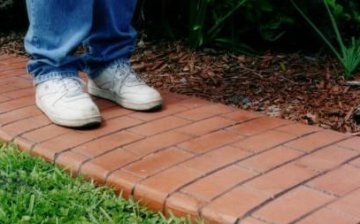
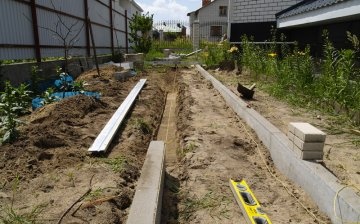
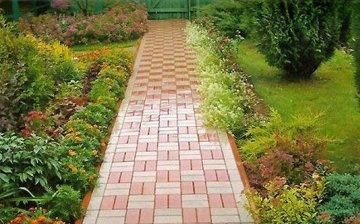

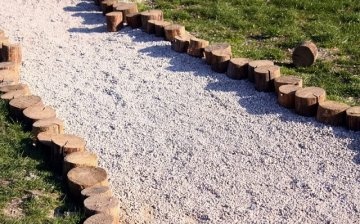
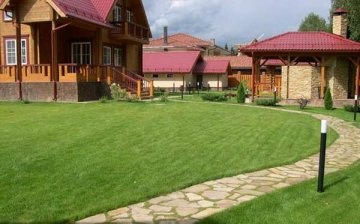

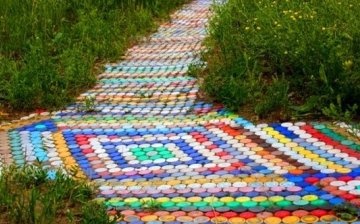








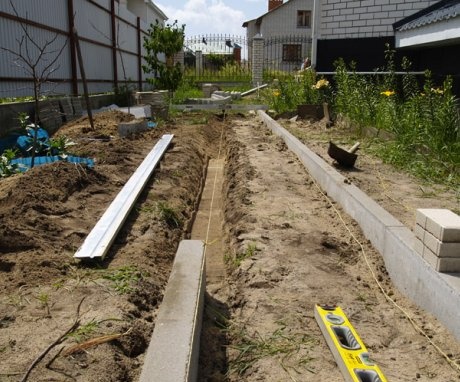
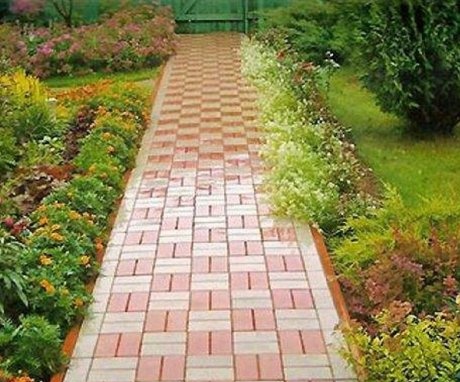
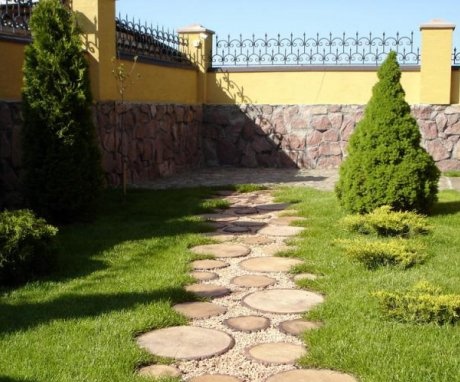
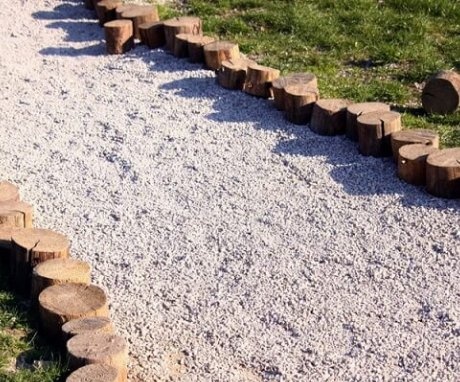

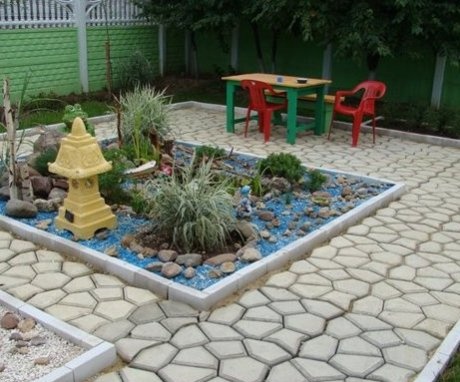
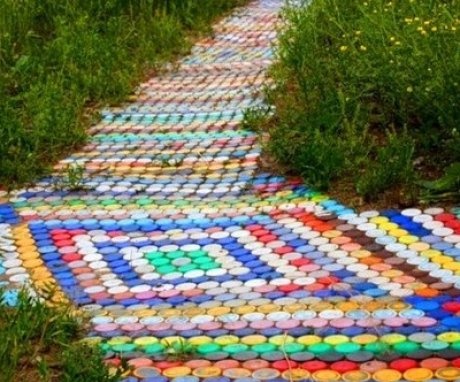
I can only dream of such beautiful paths as described in the article. At my dacha, the paths are simply sprinkled with gravel. But this is only "for now". I took a closer look at a path made of sawdust and round timber. Original and simple at the same time.
For a long time I saw a not very expensive idea of how to make paths with the help of cement and a large burdock so that they look as if they were laid out from leaves .. I want to bring this idea to life.
A path made of bricks is the easiest and most familiar of all, so I would make this particular option, it looks very strict in its own way and at the same time neat and beautiful, it will hold on for a long time.
In Soviet times, my father himself made small biton slabs and laid out paths with them, and sowed lawn grass between them. Now everything is facilitated by the purchase of paving slabs, the main thing is the availability of funds.